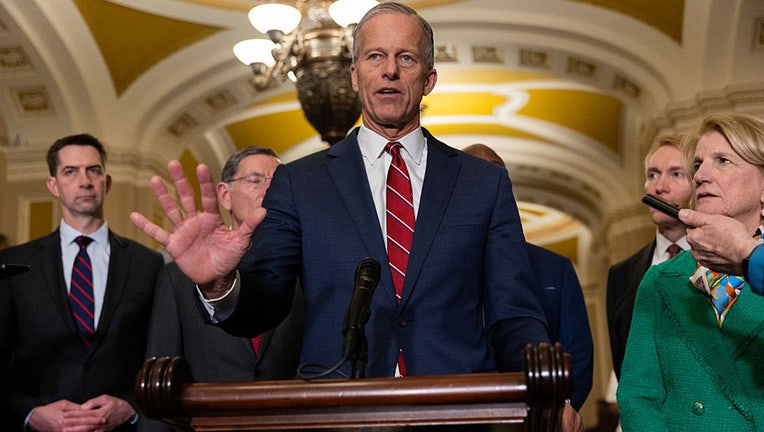Trump tax-cut package moving forward in Senate

FILE - Senate Majority Leader John Thune (R-SD) speaks at a press conference with other members of Senate Republican leadership, following weekly policy luncheons, in Washington, DC on April 1, 2025. (Photo by Nathan Posner/Anadolu via Getty Images)
WASHINGTON - Republican senators met with President Donald Trump as they pushed ahead on his big bill of tax breaks and spending cuts.
Lawmakers did not, however, answer some of the more difficult questions, such as the cost and how to pay for the multitrillion-dollar package.
What’s in the package?
Dig deeper:
The Senate GOP’s budget framework would be the companion to the House Republicans' $4.5 trillion tax cuts package that also calls for cutting some $2 trillion from health care and other programs.
If the Senate can move the blueprint forward, it would edge Trump's allies on Capitol Hill closer to a compromise setting the stage for a final product in the coming weeks.
What's next:
Typically, the current policy baseline proposal would need to pass the muster of the Senate's nonpartisan parliamentarian to ensure it abides by the strict rules of the budget process.
GOP leaders say they don’t necessarily need the Senate parliamentarian, at this point, to resolve the issue, and they believe Sen. Lindsey Graham of South Carolina, as the Senate Budget Committee chairman, has the authority to allow their current policy baseline approach.
GOP leaders will want to get this package passed early. That means a lengthy all-night vote that could drag into the weekend. Once that’s done, they will sort out the details later as the Republicans, facing Democratic opposition, build the actual package for consideration in the weeks, if not months, ahead.
Democrats prepare to oppose the package
Democrats are preparing to oppose the GOP tax plans as giveaways to the wealthy.
They warn Republicans plan to cut government programs and services that millions of Americans depend on nationwide.
What they're saying:
"We are standing together against the GOP tax scam and in defense of the American people," House Democratic leader Hakeem Jeffries said alongside others on the Capitol steps late Tuesday.
How will the federal government pay for this?
One main sticking point between the House and Senate GOP plans has been over whether the existing tax cuts, which are estimated to cost the federal government $4.5 trillion over the decade in lost revenue, need to be paid for by spending reductions elsewhere.
Adding Trump's new tax breaks to the package would balloon the price tag.
Dig deeper:
To offset the costs, House Republicans are demanding some $2 trillion in cuts to health care and other accounts to stem federal deficits and prevent the nation's $36 trillion debt load from skyrocketing.
But GOP senators have a different approach. They take the view that because the tax cuts are already the current policy, they would not be new and would not need to be paid for. They want to use this current policy baseline moving forward, meaning only Trump's other proposed tax breaks would come with a new cost. They are expected to set much lower spending cuts as a floor that can be raised, if needed, to compromise with the House's $2 trillion in cuts.
The other side:
Senate Minority Leader Chuck Schumer of New York and top Democrats call the Senate GOP's approach a gimmick at best, if not an outright "lie."
What they're saying:
"It is an obscene fraud and the American people won’t stand for it," said Schumer, Sen. Jeff Merkley of the Budget Committee and Sen. Ron Wyden of the Finance Committee in a letter to GOP leadership.
Democratic Sen. Cory Booker of New Jersey argued against the GOP baseline as "a gimmick" that would cut important federal services while growing deficits.
"What they're investing in is bigger tax cuts for the wealthiest," Booker said during a landmark overnight speech.
The Source: Information for this article was gathered from The Associated Press and previous reporting from LiveNOW from FOX. This story was reported from Los Angeles.

